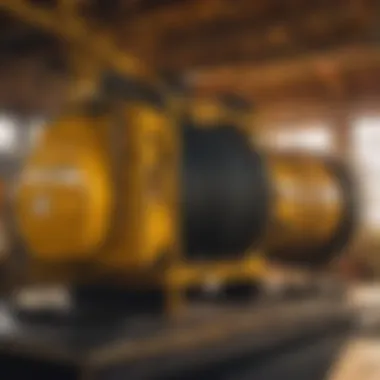Materials:
- Two gallons of creosote remover
- Chimney brush
- Safety goggles
- Gloves
- Dust mask
DIY Steps:
- Begin by preparing the area around the chimney or wood-burning stove by laying down protective sheets.
- Put on safety goggles, gloves, and a dust mask to protect yourself from creosote particles.
- Use the chimney brush to scrub the interior walls of the chimney thoroughly.
- Apply the creosote remover generously, following the manufacturer's instructions carefully.
- Allow the remover to sit for the specified amount of time to penetrate and break down the creosote buildup.
- Use the chimney brush again to scrub off the loosened creosote residue.
- Dispose of the removed creosote residue properly.
Technical Aspects:
- Tools: Chimney brush, safety goggles, gloves, dust mask
- Timing: Allocate at least 2 hours for the creosote removal process
- Critical Techniques: Ensure thorough scrubbing and proper disposal of creosote residue
DIY Project Process:


- Start by protecting yourself with safety gear.
- Scrub the chimney walls with the brush and apply the creosote remover.
- Wait for it to work and scrub again to remove loosened buildup.
- Dispose of the residue carefully to prevent recontamination.
Troubleshooting Tips:


- If creosote buildup is stubborn, consider repeating the process or seeking professional help.
- Ensure proper ventilation while working with creosote remover to avoid inhaling harmful fumes.
Introduction


Creosote buildup is a pressing issue across various settings, including chimneys, wood-burning stoves, and industrial equipment. This article aims to provide an in-depth understanding of creosote accumulation, its formation, associated risks, and preventive measures to manage it effectively. By shedding light on this overlooked yet critical topic, readers will gain valuable insights into safeguarding their homes and enhancing equipment longevity.
Defining Creosote
Chemical Composition of Creosote
Creosote's chemical composition is a complex blend of aromatic hydrocarbons, phenols, and cresols, derived from the incomplete combustion of organic materials such as wood. These compounds contribute to the sticky, black residue that accumulates in various heating systems. While creosote is a common byproduct of combustion, its flammability poses significant risks. Understanding the chemical composition helps in identifying creosote buildup and implementing appropriate maintenance strategies to mitigate fire hazards and ensure optimal equipment performance.
Physical Characteristics
The physical characteristics of creosote include its tar-like consistency, distinct odor, and dark coloration. Creosote has a high carbon content, making it a formidable insulator. While this insulation property can enhance heat retention within the system, excessive buildup can lead to reduced efficiency and potential blockages. Moreover, creosote's corrosive nature can accelerate wear and tear on equipment, necessitating regular cleaning and maintenance to prevent operational disruptions.
Formation Process
Conditions Favoring Creosote Buildup
Creosote buildup thrives under specific conditions, including low chimney temperatures, restricted airflow, and burning unseasoned wood. These factors contribute to incomplete combustion, leading to the deposition of creosote on the chimney walls. Recognizing these conducive conditions is vital for homeowners to adopt proper burning practices, maintain adequate airflow, and schedule regular chimney inspections to prevent creosote accumulation and maintain efficient combustion.
Interaction with Combustion Byproducts
Creosote interacts with combustion byproducts, such as soot and ash, to form a potentially combustible layer within heating systems. The acidic components in creosote can corrode metal surfaces, compromising the structural integrity of chimneys and equipment. By understanding the interplay between creosote and combustion residues, homeowners can anticipate maintenance needs, select appropriate cleaning methods, and safeguard against fire hazards and performance degradation.
Significance of Addressing Creosote Accumulation
Fire Hazards
Creosote accumulation poses a significant fire hazard, as the highly flammable residue can ignite within the chimney and escalate into a dangerous chimney fire. The combustibility of creosote underscores the critical need for regular maintenance, inspections, and proper disposal techniques to reduce the risk of fire incidents. By prioritizing creosote management, homeowners can safeguard their properties and family members from the devastating consequences of chimney fires.
Health Implications
In addition to fire risks, creosote accumulation can have adverse health implications for household occupants. Exposure to creosote fumes and particles during combustion can lead to respiratory irritations, allergies, and potential long-term health consequences. Addressing creosote buildup is essential not only for property protection but also for maintaining a safe and healthy indoor environment. Implementing preventative measures and timely cleaning practices can mitigate health risks associated with creosote exposure, ensuring a safer living environment for residents.
Creosote Buildup in Chimneys
Importance of Creosote Buildup in Chimneys
Impact on Chimney Efficiency
Reduced Draft Efficiency:
When creosote accumulates within chimneys, one significant consequence is a reduced draft efficiency. This reduced airflow can lead to poor combustion, diminished heat production, and increased smoke within the interior space. The key characteristic of reduced draft efficiency lies in its ability to impede the smooth flow of gases up and out of the chimney, affecting the overall performance of the heating system. This adverse effect not only impacts the comfort of the household but also raises safety concerns due to the potential buildup of toxic gases indoors.
Potential Blockages:
Another critical aspect of creosote buildup in chimneys is the formation of potential blockages. As creosote solidifies and sticks to the chimney walls, it can restrict the passage for gases to escape. Blockages not only hamper the chimney's ability to function optimally but also increase the risk of backdrafts, where smoke re-enters the living space. Addressing potential blockages promptly is essential to prevent dangerous situations and maintain the smooth operation of the chimney system.
Preventive Measures
Regular Inspections:
Implementing regular chimney inspections is a fundamental preventive measure against creosote buildup. These inspections, conducted by certified professionals, involve assessing the chimney's interior for any signs of creosote accumulation or blockages. By identifying these issues early on, homeowners can take timely action to remove creosote deposits and ensure the chimney remains clear and efficient. Regular inspections are a proactive approach to maintaining a safe and functional chimney system.
Proper Burning Practices:
Alongside inspections, practicing proper burning techniques is crucial in preventing excessive creosote buildup. By using seasoned wood, maintaining a hot fire, and avoiding smoldering fires, homeowners can reduce the production of creosote during combustion. Additionally, ensuring adequate ventilation and appropriate sizing of wood logs can contribute to cleaner burning and less creosote formation. Incorporating these proper burning practices into daily use of the chimney helps to minimize creosote buildup and promote overall efficiency.
Creosote Accumulation in Wood-Burning Stoves
In this article, understanding creosote accumulation in wood-burning stoves holds pivotal importance as it sheds light on a common yet critical issue faced by many homeowners. The focus on this specific topic allows us to delve into the nuances of how creosote buildup affects the functionality and safety of wood-burning stoves.
This section serves as a comprehensive guide, detailing key elements such as the impact of operating conditions on creosote formation, the benefits of maintaining a clean stove, and crucial considerations for preventing hazardous accumulation.
Operating Conditions Favoring Creosote
Low Temperatures
Low temperatures play a significant role in promoting creosote buildup within wood-burning stoves. The key characteristic of low temperatures is their ability to restrict the complete combustion of wood, leading to the incomplete breakdown of volatile compounds and the subsequent formation of creosote.
While low temperatures may be favorable for slow-burning fires, they pose a considerable risk in terms of creosote accumulation. Homeowners often opt for lower temperatures to prolong heat output, not realizing the adverse effects it can have on their stove's efficiency and safety.
The unique feature of low temperatures lies in their capacity to create a cozy ambiance, but this comfort can come at a cost if proper precautions are not taken. Understanding the balance between warmth and creosote buildup is crucial for maintaining a healthy wood-burning stove.
Moisture Content in Wood
The moisture content in wood also significantly impacts creosote accumulation in stoves. High moisture levels in wood contribute to the production of excess smoke, which contains various organic compounds that condense into creosote within the stove's flue.
The key characteristic of moisture content in wood is its ability to influence the combustion process. Wet or unseasoned wood generates more smoke, increasing the likelihood of creosote formation and deposition within the chimney.
While using wood with higher moisture content may seem convenient, given its availability, it comes with the disadvantage of promoting creosote buildup. Homeowners must prioritize well-seasoned, dry wood to minimize the risks associated with excessive moisture content.
Cleaning Techniques
Effective cleaning techniques are essential for mitigating creosote accumulation in wood-burning stoves, ensuring optimal performance and safety for household members. This section explores two primary methods – the use of creosote removers and mechanical cleaning – highlighting their significance in maintaining a clean and efficient stove.
Use of Creosote Removers
Integrating creosote removers into regular maintenance routines can significantly reduce creosote buildup in wood-burning stoves. The key characteristic of these products is their ability to break down creosote deposits, preventing chimney obstructions and potential fire hazards.
Choosing to use creosote removers is a beneficial practice due to their convenience and effectiveness in dissolving stubborn creosote formations. Homeowners can easily apply these solutions to their stoves, promoting thorough combustion and minimizing the risk of creosote-related incidents.
The unique feature of using creosote removers lies in their ability to enhance stove performance while ensuring a safer environment for occupants. By incorporating these products into regular stove maintenance, homeowners can proactively address creosote buildup and maintain a functional heating appliance.
Mechanical Cleaning Methods
Mechanical cleaning methods offer a hands-on approach to eliminating creosote deposits in wood-burning stoves, providing a thorough solution for reducing fire hazards and enhancing stove efficiency. The key characteristic of mechanical cleaning is its direct intervention in physically removing creosote buildups from the stove surfaces.
Opting for mechanical cleaning methods proves to be a popular choice among homeowners due to its immediate and visible results. By employing brushes, scrapers, and other tools specifically designed for creosote removal, individuals can actively dislodge and extract creosote, preventing chimney blockages and potential safety risks.
The unique feature of mechanical cleaning methods is their ability to offer a more hands-on and intensive approach to creosote removal. While requiring manual effort, these methods provide a thorough and effective way to address creosote accumulation, ensuring the longevity and efficiency of wood-burning stoves.
Industrial Equipment and Creosote Buildup
In exploring the multifaceted realm of creosote buildup within various settings, the segment on Industrial Equipment holds particular significance. Industrial equipment plays a pivotal role in many operations, ranging from manufacturing processes to energy production. The accumulation of creosote within such equipment can pose serious challenges that can impact their efficiency and longevity.
Effects on Efficiency
Heat Transfer Reduction
The phenomenon of Heat Transfer Reduction within industrial equipment due to creosote buildup is a critical aspect that warrants attention in this article. This diminution in heat transfer can lead to a decrease in the effectiveness of equipment functions, resulting in reduced operational efficiencies and productivity. Heat Transfer Reduction is a prime concern as it directly affects the heat exchange mechanisms within the equipment, impacting overall performance. Despite its detrimental effects, understanding Heat Transfer Reduction can aid in devising targeted strategies to mitigate creosote buildup effectively in industrial settings.
Increased Energy Consumption
Another vital consideration in the context of Industrial Equipment and Creosote Buildup is the escalations in energy consumption that result from this phenomenon. The increased energy consumption stems from the compromised efficiency of equipment due to creosote accumulation, leading to higher energy input requirements to maintain operational functionality. This surge in energy consumption not only inflates operational costs but also contributes to environmental impacts through heightened energy usage and emissions. Balancing the need for equipment functionality with energy efficiency becomes paramount in addressing the challenges posed by Increased Energy Consumption due to creosote buildup.
Mitigation Strategies
Regular Maintenance Schedules
Implementing proactive measures like Regular Maintenance Schedules is key to combating the repercussions of creosote buildup in industrial equipment. Regular maintenance, including periodic cleaning and inspection routines, can prevent excessive creosote accumulation, thereby preserving equipment efficiency and prolonging its lifespan. By adhering to a structured maintenance schedule, potential hazards associated with creosote buildup can be mitigated, ensuring smooth operations and minimizing downtime. The emphasis on Regular Maintenance Schedules aligns with the goal of sustaining optimal equipment performance in the face of creosote-related challenges.
Utilization of Alternative Fuels
Embracing the concept of Utilization of Alternative Fuels offers a strategic approach to controlling creosote buildup and its detrimental effects on industrial equipment. Alternative fuels with lower creosote-producing tendencies present a viable solution to curbing creosote accumulation while maintaining operational requirements. The utilization of alternative fuels not only reduces the risk of creosote-related issues but also promotes environmental sustainability and resource efficiency. Integrating alternative fuel sources into industrial processes serves as a proactive measure to address creosote buildup challenges effectively.
Conclusion
Importance of Proactive Creosote Management
Ensuring Safety
The cornerstone of proactive creosote management lies in ensuring safety. In the context of this article, safety plays a pivotal role in mitigating the potential hazards associated with creosote accumulation. Emphasizing the need for a secure operational environment, ensuring safety through proactive creosote management engenders a sense of reassurance. The key characteristic of this approach is its proactive nature in averting possible fire incidents and health risks. By prioritizing safety measures and integrating them into creosote management strategies, individuals can safeguard their homes and loved ones from the dangers posed by creosote buildup. While the advantages of ensuring safety in this article are unmistakably clear, its relevance cannot be overstated, making it a choice that resonates deeply with the underlying objective of this comprehensive guide.
Enhancing Equipment Longevity
Another pivotal aspect of proactive creosote management is its contribution to enhancing equipment longevity. By proactively addressing creosote buildup, individuals can extend the lifespan of their chimneys, wood-burning stoves, and industrial equipment. The key characteristic of this approach is its ability to reduce the wear and tear caused by creosote, thus ensuring the equipment functions optimally for a longer duration. Opting for enhancing equipment longevity through proactive creosote management proves to be a popular choice for readers seeking to maximize the performance and durability of their essential appliances. The unique feature of this strategy lies in its dual benefit of not only preventing potential malfunctions due to creosote buildup but also elevating the overall efficiency of the equipment. While discussing the advantages and disadvantages in this article, it becomes apparent that enhancing equipment longevity through proactive creosote management is a prudent decision that pays dividends in the long run.





